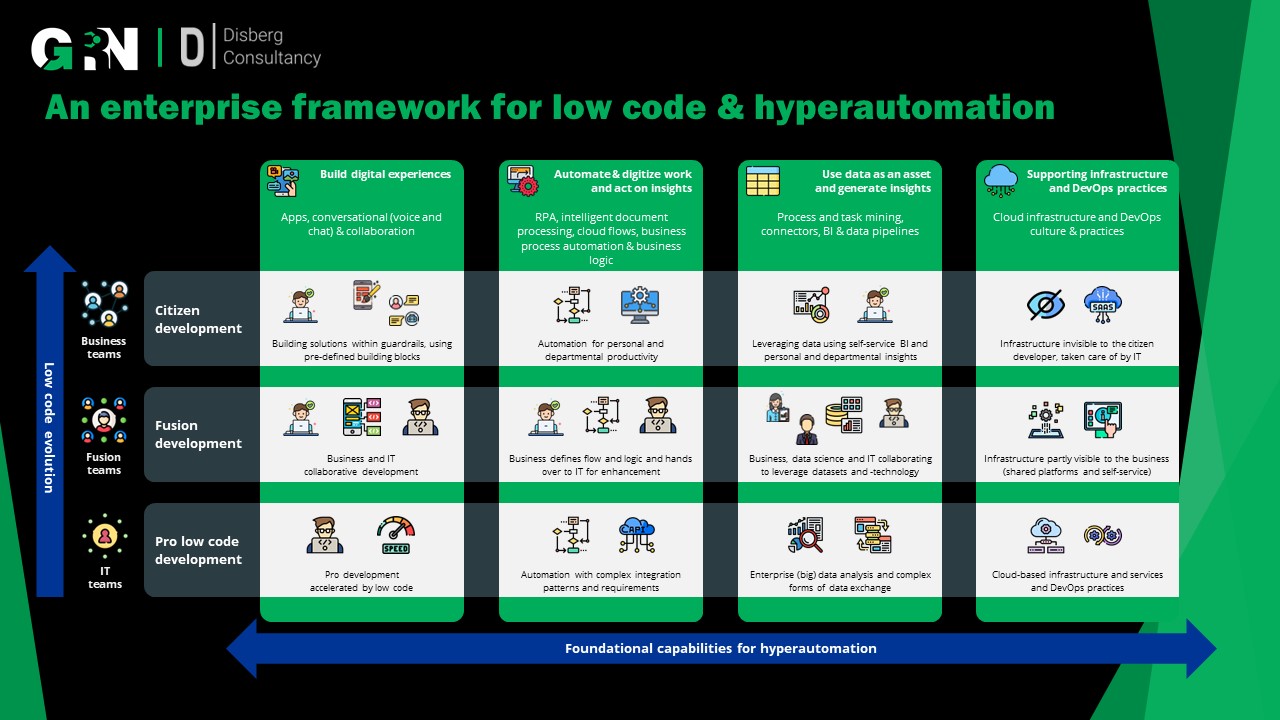Don't get lost in low code and hyperautomation

Chris Vinke, CEO & founder GRN Consultancy

Arnaud Disberg, Intelligent Automation Specialist

Ewout Masereeuw, Automation Expert
In our field, we regularly talk to various stakeholders about low code and hyperautomation. Usually these are good conversations, with the right intentions, but often with unnoticed speech confusion. That speech confusion stems from different perceptions low code and hyperautomation. As a result, choices made do not always turn out to be the right choices or are based on the wrong assumptions. To arrive at a common perception of low code and hyperautomation, we have created a map to help organisations do so.
Why a map?
A good map allows you to orientate and navigate. Where are you standing? Where do you want to go? How can you get there? And what will you encounter on the way?
A good map provides an overview and insight, but above all it is a communication tool to arrive at a shared view and awareness of the environment and our own position in it. If we succeed in this, we understand each other better and can make better choices together.
Tip: Kijk eens naar Wardley Mapping als je meer wil leren over het nut van kaarten in organisaties.
The starting point on the map
In this article series, we present a map to help navigate the world of low code and hyperautomation. The starting point on this map is our definition of low code and hyperautomation:
- Low code literally means 'less code' and is an evolution in the approach to developing software, with the aim of writing less code (less 'programming'), instead 'putting together' applications and making them accessible to a wider audience. That goal is achieved through abstraction of code with graphical building blocks and models and automation of the generation process.
- Hyperautomation is a working method that aims to achieve automation-by-design by combining and integrating different solutions. The aim of the method is to (quickly) achieve far-reaching automation in business processes where this was not possible before.
Why is a card needed for low code and hyperautomation?
Like the route from Amsterdam to Berlin, the playing field of low code and hyperautomation changes regularly and the route contains many choices to be made along the way.
Low code is a requirement and accelerator for hyperautomation, but hyperautomation is simultaneously an accelerator for low code
That the playing field of low code and hyperautomation is so dynamic has four primary reasons.
Business drivers
Low code and hyperautomation share the strong business drivers of cloud:
- Capacity – waar cloud voornamelijk voorziet in de technische capaciteit van een organisatie, voorziet low code in de menselijke capaciteit en draagt daarmee bij aan het verkleinen van de digital talent gap.
- Cost reduction - the cost of software development and maintenance can be drastically reduced with low code, and hyperautomation aims to reduce costs across the board through automation-by-design.
- Agility – low code en hyperautomation dragen bij aan de wendbaarheid van organisaties door toe te werken naar de composable enterprise.
Speed
Door de concurrentie en groei van de low code markt (3x sneller dan het marktgemiddelde) evolueert technologie zeer snel van introductie tot gemeengoed en breiden low code platforms snel uit door het toevoegen van aanvullende hyperautomation functionaliteit (zgn. horizontale uitbreiding) of marktspecifieke functionaliteit (zng. verticale uitbreiding).
Diversity
Low code wordt toegepast voor een breed palet aan oplossingen, van relatief eenvoudige apps tot volledige ERP rationalisatie tot multiexperience B2C oplossingen en komt terug in alle facetten van hyperautomation.
Methodology
Hyperautomation is een ambitie die IT niet zonder nauwe samenwerking met de business kan waarmaken. Low code is daarom een vereiste en versneller voor hyperautomation, maar hyperautomation is tegelijkertijd ook een versneller voor low code. Vanwege deze samenwerking tussen IT en business kent low code een aantal unieke werkwijzen (citizen en fusion development) waaruit een organisatie kan/moet kiezen, met ieder hun eigen uitdagingen.

Alle modellen zijn fout, maar sommige zijn nuttig - George Box
Filling in the map is specific to a specific organisation, at a moment in time. If you fill in the map again at a later point in time, the playing field often looks very different, because the organisation has grown, made choices and the market has changed.
Taking the map out at regular intervals gives a picture of the position of different components such as ways of working, knowledge, people and technology. What is moving? Where is there innovation? Where are the challenges located?
As an organisation, our map helps you make the right choices, map out routes and align perspectives.